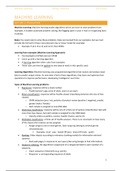Summary
Machine Learning: Comprehensive Summary
- Course
- Institution
Very useful summary for the Machine Learning course at Tilburg University (Data Science and Society). Summary contains all parts that are discussed in the course (2019) extra examples, explanation and notes. Summary also contains many useful visualizations.
[Show more]



